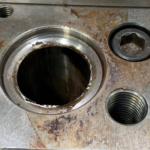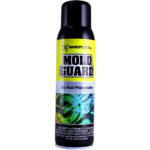Rust is more than a cosmetic issue, it’s a costly threat to injection mold performance, part quality, and production uptime. Whether you’re running high-volume plastic parts or precision tooling for medical components, rust can compromise tolerances, increase scrap rates, and lead to expensive mold repairs. The good news? With the right rust prevention spray or strategy, you can stop corrosion before it starts.
Why Injection Molds Are Vulnerable to Rust
 Injection molds are typically made from tool steels that are susceptible to oxidation, especially in humid environments or during downtime. Moisture from condensation, cooling lines, or cleaning processes can settle into cavities, vents, and parting lines, creating ideal conditions for rust formation. Even short exposure can lead to pitting, surface degradation, and flash issues on molded parts.
Injection molds are typically made from tool steels that are susceptible to oxidation, especially in humid environments or during downtime. Moisture from condensation, cooling lines, or cleaning processes can settle into cavities, vents, and parting lines, creating ideal conditions for rust formation. Even short exposure can lead to pitting, surface degradation, and flash issues on molded parts.
The Role of Rust Prevention Spray
Rust prevention sprays are a frontline defense against corrosion. These sprays form a protective barrier on mold surfaces, displacing moisture and shielding metal from oxygen exposure. When applied correctly, they:
- Prevent rust during storage and idle periods
- Protect molds during transport or maintenance
- Extend tool life and reduce repair costs
- Maintain surface finish and dimensional accuracy
Look for rust protection sprays that are compatible with mold materials, easy to apply, and leave minimal residue. Some formulas are designed to evaporate cleanly during mold startup, while others require a quick wipe-down before production resumes.
Best Practices for Rust Prevention
To keep your molds rust-free, integrate these steps into your maintenance routine:
- Apply rust protection spray immediately after cleaning or shutdown
- Purge cooling lines and air-blow cavities to remove moisture
- Store molds in climate-controlled environments when possible
- Use desiccant packs or dehumidifiers in mold storage areas
- Inspect and reapply rust protection regularly, especially in humid seasons
Choosing the Right Rust Protection Spray
 Not all sprays are created equal. When selecting a rust prevention spray, consider:
Not all sprays are created equal. When selecting a rust prevention spray, consider:
- Dry vs. oily film – Dry films are cleaner for startup; oily films offer longer protection
- Residue removal – Some sprays require cleaning before molding; others burn off safely
- Application method – Aerosol, pump, or bulk options depending on your workflow
- Material compatibility – Ensure the spray won’t react with mold coatings or inserts
For long-term protection and minimal downtime, choose a spray that aligns with your mold materials and production schedule.
Stop Rust Before It Starts
Rust prevention is proactive, not reactive. By integrating rust protection spray into your mold care routine, you safeguard your tooling investment and keep production running smoothly.
Contact NanoPlas today to learn which spray is right for your molds, how to apply it effectively, and how to build a rust-proof maintenance plan.
